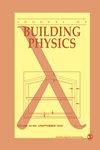Multivariate analysis for assessing the thermal performance of vertical opaque envelopes in extended regions
IF 1.8
4区 工程技术
Q3 CONSTRUCTION & BUILDING TECHNOLOGY
引用次数: 1
Abstract
We introduce a statistical methodology to evaluate the thermal performance of vertical opaque envelopes and provide the most adequate design of energy-efficient buildings located across extended regions. The analytical procedure was applied to the extensive Argentinian territory with a variety of climates and a limited number of networked meteorological stations. Although the study was conducted over a full year, results are presented for January and June, when the building energy demand for heating and cooling is most significant, taking into account the local climate, the thermal properties of the walls and the effects of the daily variation in the solar radiation. By using the Fourier series expansion of the sol-air temperature and multivariate analysis, we first correlated the weather data and the steady-state and time-dependent heat fluxes transmitted by conduction through five types of typical walls facing north and south in 10 climatically differentiated cities where full weather data were recorded. Then, the mean values of the sol-air temperature and the amplitude of its time variations were interpolated throughout the territory, thus yielding the spatial distributions of these parameters for a typical day in the months of interest. Finally, the calculation of the heat fluxes exchanged through building opaque envelopes was extended to the whole country.扩展区域垂直不透明信封热性能评估的多变量分析
我们引入了一种统计方法来评估垂直不透明围护结构的热性能,并为位于扩展区域的节能建筑提供最适当的设计。该分析程序适用于阿根廷广阔的领土,其气候多种多样,联网气象站数量有限。虽然这项研究进行了整整一年,但考虑到当地气候、墙壁的热性能和太阳辐射的每日变化的影响,研究结果是在1月和6月提出的,当时建筑对供暖和制冷的能源需求最为显著。本文首先利用土壤-空气温度的傅立叶级数展开和多变量分析,将10个气候差异城市的天气数据与5种典型南北向墙体的稳态热通量和随时间变化的热通量联系起来。然后,在整个领土内插值太阳-空气温度的平均值及其时间变化幅度,从而得到这些参数在感兴趣的月份中典型日的空间分布。最后,将建筑不透明围护结构交换热流的计算推广到全国。
本文章由计算机程序翻译,如有差异,请以英文原文为准。
求助全文
约1分钟内获得全文
求助全文
来源期刊

Journal of Building Physics
工程技术-结构与建筑技术
CiteScore
5.10
自引率
15.00%
发文量
10
审稿时长
5.3 months
期刊介绍:
Journal of Building Physics (J. Bldg. Phys) is an international, peer-reviewed journal that publishes a high quality research and state of the art “integrated” papers to promote scientifically thorough advancement of all the areas of non-structural performance of a building and particularly in heat, air, moisture transfer.
 求助内容:
求助内容: 应助结果提醒方式:
应助结果提醒方式:


